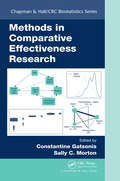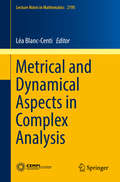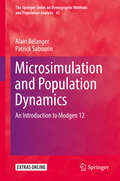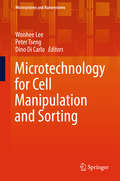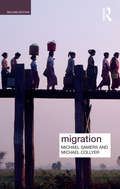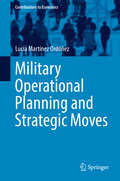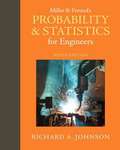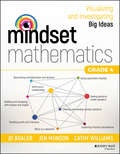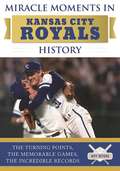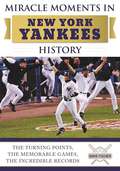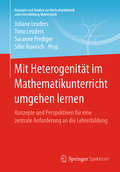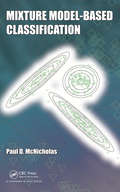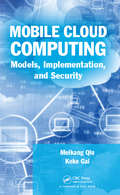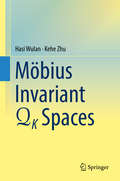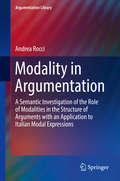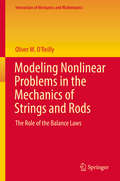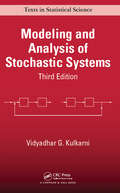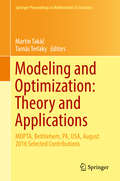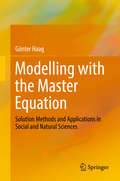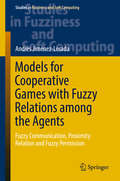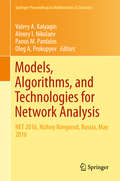- Table View
- List View
Methods in Comparative Effectiveness Research (Chapman & Hall/CRC Biostatistics Series)
by Sally C. Morton Constantine GatsonisComparative effectiveness research (CER) is the generation and synthesis of evidence that compares the benefits and harms of alternative methods to prevent, diagnose, treat, and monitor a clinical condition or to improve the delivery of care (IOM 2009). CER is conducted to develop evidence that will aid patients, clinicians, purchasers, and health policy makers in making informed decisions at both the individual and population levels. CER encompasses a very broad range of types of studies—experimental, observational, prospective, retrospective, and research synthesis. This volume covers the main areas of quantitative methodology for the design and analysis of CER studies. The volume has four major sections—causal inference; clinical trials; research synthesis; and specialized topics. The audience includes CER methodologists, quantitative-trained researchers interested in CER, and graduate students in statistics, epidemiology, and health services and outcomes research. The book assumes a masters-level course in regression analysis and familiarity with clinical research.
Metrical and Dynamical Aspects in Complex Analysis (Lecture Notes in Mathematics #2195)
by Léa Blanc-CentiThe central theme of this reference book is the metric geometry of complex analysis in several variables. Bridging a gap in the current literature, the text focuses on the fine behavior of the Kobayashi metric of complex manifolds and its relationships to dynamical systems, hyperbolicity in the sense of Gromov and operator theory, all very active areas of research. The modern points of view expressed in these notes, collected here for the first time, will be of interest to academics working in the fields of several complex variables and metric geometry. The different topics are treated coherently and include expository presentations of the relevant tools, techniques and objects, which will be particularly useful for graduate and PhD students specializing in the area.
Microsimulation and Population Dynamics
by Alain Bélanger Patrick SabourinThis book is a practical, step-by-step introduction to microsimulation in demography. It shows how to use Modgen, a powerful and free microsimulation platform built by Statistics Canada. The authors' hands-on explanation of model development will help readers make their own. The book teaches how to create and run a simple cohort model with a single fixed-rate event, and builds upon this concept. It introduces how to develop both a single state life table as well as a multiple increment-decrement life table using the tools provided by Modgen. The authors illustrate how to easily upgrade an existing model by adding new modules and new dimensions as determinants of a risk already modeled. The integration of a fertility module and a base population allows the user to bring new actors into the simulation and transform a cohort-based model into a population-based one. The final addition of an international migration module allows the user to accomplish fully open, multi-regional projections. This accessible introduction will be of interest to researchers and students in population studies and other social sciences. It will also appeal to anyone interested in the computational modeling of population dynamics.
Microtechnology for Cell Manipulation and Sorting
by Wonhee Lee Peter Tseng Dino Di CarloThis book delves into the recent developments in the microscale and microfluidic technologies that allow manipulation at the single and cell aggregate level. Expert authors review the dominant mechanisms that manipulate and sort biological structures, making this a state-of-the-art overview of conventional cell sorting techniques, the principles of microfluidics, and of microfluidic devices. All chapters highlight the benefits and drawbacks of each technique they discuss, which include magnetic, electrical, optical, acoustic, gravity/sedimentation, inertial, deformability, and aqueous two-phase systems as the dominant mechanisms utilized by microfluidic devices to handle biological samples. Each chapter explains the physics of the mechanism at work, and reviews common geometries and devices to help readers decide the type of style of device required for various applications. This book is appropriate for graduate-level biomedical engineering and analytical chemistry students, as well as engineers and scientists working in the biotechnology industry.
Middle School Math Solution, Course 2
by Sandy Bartle Finocchi Amy Jones Lewis Kelly Edenfield Josh FisherNIMAC-sourced textbook
Migration (Key Ideas in Geography)
by Michael Collyer Michael SamersWhile the subject of migration has received enormous attention in academic journals and books across the social sciences, introductory texts on the matter are few and far between. Even fewer books have explored migration through a critical and explicit engagement with spatial concepts. Now in its second edition, Migration remains the only text in more than a decade that emphasizes how geographical or spatial concepts can be used critically to understand migration. The multi-disciplinary text draws on insights from human geography, political science, social anthropology, sociology, and to a lesser extent economics. All of the chapters focus on key terms, theories, concepts, and issues concerning migration and immigration. The book argues that in the context of migration, two opposing ‘spatial positions’ have emerged in the wake of the critique of ‘methodological nationalism’. On one hand is the significance of ‘transnationalism’, and on the other, the importance of ‘sub-national’ or local processes. Both require more nuance and integration, while many of the concepts and theories which have thus far neglected space or have not been ‘treated’ spatially, need to be re-written with space in mind. Pedagogically the text combines a carefully defined structure, accessible language, boxes that explore case studies of migrant-related experiences in particular places, annotated suggestions for further reading, useful websites and relevant films and summary questions for student learning at the end of each chapter. Migration provides a critical, multi-disciplinary, advanced, and theoretically informed introduction to migration and immigration. Revised and updated with new material, new maps and illustrations and an accompanying website (https://migration2ndedition.wordpress.com/), it continues to be aimed at advanced undergraduates and Masters-level graduate students undertaking courses on migration and immigration.
Military Operational Planning and Strategic Moves
by Lucía Martínez OrdóñezThis book employs game theory to warfare and in particular to military operations. It aims at scrutinizing the validity of the two ideas that have governed the literature on war and warfighting: One is the Clausewitzian Fog of War, which suggests that he who is able to "see" through the gunsmoke and observe his opponent’s moves before he has to commit to some strategy himself, should be able to gain an advantage over that enemy; the other is the tradition of understanding military conflict as a zero-sum game. Combined, these ideas seem to imply that war always gives rise to a second-mover advantage. This book questions the validity of this presumption at the operational level of military planning. It provides a simple but rigorous game-theoretic framework in order to analyse operational alternatives for a whole range of typical conflicts Western military forces are facing, including the most recent ones such as Anti-Access/Area-Denial and supporting host nations' counterinsurgency campaigns.
Miller & Freund's Probability and Statistics for Engineers
by Richard A. JohnsonThis book introduces probability and statistics to students of engineering and the physical sciences. It is primarily applications focused but it contains optional enrichment material. Miller & Freund's Probability and Statistics for Engineers is rich in exercises and examples, and explores both elementary probability and basic statistics, with an emphasis on engineering and science applications. The text emphasizes designed experiments, especially two-level factorial design. The Ninth Edition includes several new datasets and examples showing application of statistics in scientific investigations, familiarizing students with the latest methods, and readying them to become real-world engineers and scientists.
Mindset Mathematics: Visualizing and Investigating Big Ideas, Grade 4 (Mindset Mathematics Ser.)
by Cathy Williams Jo Boaler Jen MunsonEngage students in mathematics using growth mindset techniques The most challenging parts of teaching mathematics are engaging students and helping them understand the connections between mathematics concepts. In this volume, you'll find a collection of low floor, high ceiling tasks that will help you do just that, by looking at the big ideas at the first-grade level through visualization, play, and investigation. During their work with tens of thousands of teachers, authors Jo Boaler, Jen Munson, and Cathy Williams heard the same message—that they want to incorporate more brain science into their math instruction, but they need guidance in the techniques that work best to get across the concepts they needed to teach. So the authors designed Mindset Mathematics around the principle of active student engagement, with tasks that reflect the latest brain science on learning. Open, creative, and visual math tasks have been shown to improve student test scores, and more importantly change their relationship with mathematics and start believing in their own potential. The tasks in Mindset Mathematics reflect the lessons from brain science that: There is no such thing as a math person - anyone can learn mathematics to high levels. Mistakes, struggle and challenge are the most important times for brain growth. Speed is unimportant in mathematics. Mathematics is a visual and beautiful subject, and our brains want to think visually about mathematics. With engaging questions, open-ended tasks, and four-color visuals that will help kids get excited about mathematics, Mindset Mathematics is organized around nine big ideas which emphasize the connections within the Common Core State Standards (CCSS) and can be used with any current curriculum.
Miracle Moments in Kansas City Royals History: The Turning Points, the Memorable Games, the Incredible Records
by Jeff DetersSince their founding in 1969, the Kansas City Royals have provided memorable moments to generations of fans in America’s heartland and beyond. Miracle Moments in Kansas City Royals History is the ultimate tribute book for die-hard fans of the team from the City of Fountains. Jeff Deters recounts the most memorable moments in Royals history, including: Steve Busby’s throwing two no-hitters in each of his first two season, a first for a big-leaguer; George Brett’s hitting .333 to win his first batting title while leading the Royals to the AL West championship in 1976; Brett’s second batting title in 1980 as he just misses batting .400 for the season; Dick Howser’s firing by the Yankees and revenge five years later as he manages the Royals to a championship in 1985; Bo Jackson’s electrifying but brief career as a Royal while starring for the Los Angeles Raiders; The Royals’ sweep of the Orioles in the 2014 ALCS to return to the World Series in 29 years; The magnificent 2015 season capped by a World Championship. Miracle Moments in Kansas City Royals History is much more than just a comprehensive resource. It recounts the hidden stories behind one of the most successful franchises in baseball..
Miracle Moments in New York Yankees History: The Turning Points, the Memorable Games, the Incredible Records
by David FischerThroughout its illustrious history, the New York Yankees have produced some of the most memorable highlights in baseball annals. Babe Ruth’s “called shot” home run, Joe DiMaggio’s 56-game hitting streak, Derek Jeter’s amazing “Flip Play.” Most Yankees fans have seen newsreel footage of Lou Gehrig’s farewell speech, watched highlights of a young Mickey Mantle, and have heard the story of Billy Martin’s five managerial hirings and firings. But what makes the Yankees the world’s most celebrated sports franchise goes beyond sheer headlines? it is the stories of the men behind the headlines who have thrilled and enchanted New York fans since 1903.Miracle Moments in New York Yankees History is the ultimate tribute book for die-hard fans of the Bronx Bombers. Whether you’re a passionate booster from the days of Yogi Berra or a newly minted supporter of Alex Rodriguez, author David Fischer has compiled a supreme collection of 50 of the most prominent and relevant team successes, player feats, and award-winning accomplishments from the Yankees’ incredible past and present. And, much like the team itself, Miracle Moments in Yankees History is about far more than just miracle moments; in-depth player profiles, exciting game details, and the perspective of time bring the greatest achievements of history’s greatest Yankees to life.Miracle Moments in New York Yankees History is much more than just a comprehensive resource. It recounts the hidden stories behind the most storied franchise in baseball.
Mit Heterogenität im Mathematikunterricht umgehen lernen
by Susanne Prediger Juliane Leuders Timo Leuders Silke RuwischIn diesem Band werden konkrete Konzepte für die Lehreraus- und -weiterbildung diskutiert, in denen Mathematik-Lehrkräfte gezielt beim Unterrichten in heterogenen und insbesondere inklusiven Klassen unterstützt werden. Auf methodischer Ebene steht die Frage im Vordergrund, wie Praxisaspekte in Lehrveranstaltungen und Fortbildungen einbezogen werden können, inhaltlich entsteht ein Spektrum von verschiedenen Themen im Kontext von Heterogenität, wie z.B. Diagnose und Förderung, Differenzierung, Begabung, Sprache und Inklusion.Die zunehmende Heterogenität der Schülerinnen und Schüler stellt für Lehrkräfte eine Herausforderung dar, auf die die Lehrerbildung vorbereiten muss. Besondere Anforderungen ergeben sich in allen Schulformen durch die erhöhte Leistungsheterogenität und durch die Inklusion von Lernenden mit Behinderungen. Der Umgang mit einer Leistungsspanne, die von Lernschwierigkeiten bis hin zu mathematischer Begabung reicht, erfordert hohe fachdidaktische Kompetenzen.
Mixture Model-Based Classification
by Paul D. McNicholas"This is a great overview of the field of model-based clustering and classification by one of its leading developers. McNicholas provides a resource that I am certain will be used by researchers in statistics and related disciplines for quite some time. The discussion of mixtures with heavy tails and asymmetric distributions will place this text as the authoritative, modern reference in the mixture modeling literature." (Douglas Steinley, University of Missouri)Mixture Model-Based Classification is the first monograph devoted to mixture model-based approaches to clustering and classification. This is both a book for established researchers and newcomers to the field. A history of mixture models as a tool for classification is provided and Gaussian mixtures are considered extensively, including mixtures of factor analyzers and other approaches for high-dimensional data. Non-Gaussian mixtures are considered, from mixtures with components that parameterize skewness and/or concentration, right up to mixtures of multiple scaled distributions. Several other important topics are considered, including mixture approaches for clustering and classification of longitudinal data as well as discussion about how to define a clusterPaul D. McNicholas is the Canada Research Chair in Computational Statistics at McMaster University, where he is a Professor in the Department of Mathematics and Statistics. His research focuses on the use of mixture model-based approaches for classification, with particular attention to clustering applications, and he has published extensively within the field. He is an associate editor for several journals and has served as a guest editor for a number of special issues on mixture models.
Mobile Cloud Computing: Models, Implementation, and Security
by Meikang Qiu Keke GaiMobile Cloud Computing: Models, Implementation, and Security provides a comprehensive introduction to mobile cloud computing, including key concepts, models, and relevant applications. The book focuses on novel and advanced algorithms, as well as mobile app development. <P><P>The book begins with an overview of mobile cloud computing concepts, models, and service deployments, as well as specific cloud service models. It continues with the basic mechanisms and principles of mobile computing, as well as virtualization techniques. The book also introduces mobile cloud computing architecture, design, key techniques, and challenges. <P><P>The second part of the book covers optimizations of data processing and storage in mobile clouds, including performance and green clouds. The crucial optimization algorithm in mobile cloud computing is also explored, along with big data and service computing. <P><P>Security issues in mobile cloud computing are covered in-depth, including a brief introduction to security and privacy issues and threats, as well as privacy protection techniques in mobile systems. The last part of the book features the integration of service-oriented architecture with mobile cloud computing. It discusses web service specifications related to implementations of mobile cloud computing. <P><P>The book not only presents critical concepts in mobile cloud systems, but also drives readers to deeper research, through open discussion questions. Practical case studies are also included. Suitable for graduate students and professionals, this book provides a detailed and timely overview of mobile cloud computing for a broad range of readers.
Mobius Invariant QK Spaces
by Hasi Wulan Kehe ZhuThis monograph summarizes the recent major achievements in M#65533;bius invariant QK spaces. First introduced by Hasi Wulan and his collaborators, the theory of QK spaces has developed immensely in the last two decades, and the topics covered in this book will be helpful to graduate students and new researchers interested in the field. Featuring a wide range of subjects, including an overview of QK spaces, QK-Teichm#65533;ller spaces, K-Carleson measures and analysis of weight functions, this book serves as an important resource for analysts interested in this area of complex analysis. Notes, numerous exercises, and a comprehensive up-to-date bibliography provide an accessible entry to anyone with a standard graduate background in real and complex analysis.
Modality in Argumentation
by Andrea RocciThis book addresses two related questions that have first arisen in Toulmin's seminal book on the uses of argument. The first question is the one of the relationship between the semantic analysis of modality and the structure of arguments. The second question is the one of the distinctive place, or role, of modality in the fundamental structure of arguments. These two questions concern how modality, as a semantic category, relates to the fundamental structure of arguments. The book addresses modality and argumentation also according to another perspective by looking at how different linguistic modal expressions may be taken as argumentative indicators. It explores the role of modal expressions as argumentative indicators by using the Italian modal system as a case study. At the same time, it uses predictions/forecasts in the business-financial daily press to investigate the relation between modality and the context of argumentation.
Model Elements and Network Solutions of Heat, Mass and Momentum Transport Processes (Heat and Mass Transfer)
by George L. DankoThis work provides an enormous contribution to the broad effort of modeling heat, mass and momentum transport in multi-physics problems with the development of new solution approaches. It re-visits the time-honored technique of network application using flow network solutions for all transport process components for a coupled modeling task. The book further provides as formulation of the conservation laws for mass, energy and momentum, specifically for the branches and nodes of transport networks using the combination of the Eulerian and Lagrangean modeling methods. With the extension of Bernoulli’s original concept, a new solution is given for the flow field of viscous and compressible fluids as driven by the balance of mechanical energy, coupled to the thermodynamics of the transport system. Applicable to simple or large-scale tasks, the new model elements and methods are built on first principles. Throughout the work, the book provides original formulations, their mathematical derivations as well as applications in a numerical solution scheme.
Model-free Hedging: A Martingale Optimal Transport Viewpoint (Chapman and Hall/CRC Financial Mathematics Series)
by Pierre Henry-LabordereModel-free Hedging: A Martingale Optimal Transport Viewpoint focuses on the computation of model-independent bounds for exotic options consistent with market prices of liquid instruments such as Vanilla options. The author gives an overview of Martingale Optimal Transport, highlighting the differences between the optimal transport and its martingale counterpart. This topic is then discussed in the context of mathematical finance.
Modeling Nonlinear Problems in the Mechanics of Strings and Rods: The Role of the Balance Laws (Interaction of Mechanics and Mathematics)
by Oliver M. O'ReillyThis book presents theories of deformable elastic strings and rods and their application to broad classes of problems. Readers will gain insights into the formulation and analysis of models for mechanical and biological systems. Emphasis is placed on how the balance laws interplay with constitutive relations to form a set of governing equations. For certain classes of problems, it is shown how a balance of material momentum can play a key role in forming the equations of motion. The first half of the book is devoted to the purely mechanical theory of a string and its applications. The second half of the book is devoted to rod theories, including Euler’s theory of the elastica, Kirchhoff ’s theory of an elastic rod, and a range of Cosserat rod theories. A variety of classic and recent applications of these rod theories are examined. Two supplemental chapters, the first on continuum mechanics of three-dimensional continua and the second on methods from variational calculus, are included to provide relevant background for students.This book is suited for graduate-level courses on the dynamics of nonlinearly elastic rods and strings.
Modeling and Analysis of Stochastic Systems (Chapman & Hall/CRC Texts in Statistical Science)
by Vidyadhar G. KulkarniBuilding on the author’s more than 35 years of teaching experience, Modeling and Analysis of Stochastic Systems, Third Edition, covers the most important classes of stochastic processes used in the modeling of diverse systems. For each class of stochastic process, the text includes its definition, characterization, applications, transient and limiting behavior, first passage times, and cost/reward models. The third edition has been updated with several new applications, including the Google search algorithm in discrete time Markov chains, several examples from health care and finance in continuous time Markov chains, and square root staffing rule in Queuing models. More than 50 new exercises have been added to enhance its use as a course text or for self-study. The sequence of chapters and exercises has been maintained between editions, to enable those now teaching from the second edition to use the third edition. Rather than offer special tricks that work in specific problems, this book provides thorough coverage of general tools that enable the solution and analysis of stochastic models. After mastering the material in the text, readers will be well-equipped to build and analyze useful stochastic models for real-life situations.
Modeling and Optimization: Theory and Applications
by Tamás Terlaky Martin TakáčThis volume contains a selection of contributions that were presented at the Modeling and Optimization: Theory and Applications Conference (MOPTA) held at Lehigh University in Bethlehem, Pennsylvania, USA on August 17-19, 2016. The conference brought together a diverse group of researchers and practitioners, working on both theoretical and practical aspects of continuous or discrete optimization. Topics presented included algorithms for solving convex, network, mixed-integer, nonlinear, and global optimization problems, and addressed the application of deterministic and stochastic optimization techniques in energy, finance, logistics, analytics, health, and other important fields. The contributions contained in this volume represent a sample of these topics and applications and illustrate the broad diversity of ideas discussed at the meeting.
Modelling with the Master Equation: Solution Methods and Applications in Social and Natural Sciences
by Günter HaagThis book presents the theory and practical applications of the Master equation approach, which provides a powerful general framework for model building in a variety of disciplines. The aim of the book is to not only highlight different mathematical solution methods, but also reveal their potential by means of practical examples.Part I of the book, which can be used as a toolbox, introduces selected statistical fundamentals and solution methods for the Master equation. In Part II and Part III, the Master equation approach is applied to important applications in the natural and social sciences.The case studies presented mainly hail from the social sciences, including urban and regional dynamics, population dynamics, dynamic decision theory, opinion formation and traffic dynamics; however, some applications from physics and chemistry are treated as well, underlining the interdisciplinary modelling potential of the Master equation approach. Drawing upon the author’s extensive teaching and research experience and consulting work, the book offers a valuable guide for researchers, graduate students and professionals alike.
Models for Cooperative Games with Fuzzy Relations among the Agents: Fuzzy Communication, Proximity Relation and Fuzzy Permission (Studies in Fuzziness and Soft Computing #355)
by Andrés Jiménez-LosadaThis book offers a comprehensive introduction to cooperative game theory and a practice-oriented reference guide to new models and tools for studying bilateral fuzzy relations among several agents or players. It introduces the reader to several fuzzy models, each of which is first analyzed in the context of classical games (crisp games) and subsequently in the context of fuzzy games. Special emphasis is given to the value of Shapley, which is presented for the first time in the context of fuzzy games.Students and researchers will find here a self-contained reference guide to cooperative fuzzy games, characterized by a wealth of examples, descriptions of a wide range of possible situations, step-by-step explanations of the basic mathematical concepts involved, and easy-to-follow information on axioms and properties.
Models, Algorithms, and Technologies for Network Analysis
by Panos M. Pardalos Valery A. Kalyagin Alexey I. Nikolaev Oleg A. ProkopyevThis valuable source for graduate students and researchers provides a comprehensive introduction to current theories and applications in optimization methods and network models. Contributions to this book are focused on new efficient algorithms and rigorous mathematical theories, which can be used to optimize and analyze mathematical graph structures with massive size and high density induced by natural or artificial complex networks. Applications to social networks, power transmission grids, telecommunication networks, stock market networks, and human brain networks are presented. Chapters in this book cover the following topics: Linear max min fairness Heuristic approaches for high-quality solutions Efficient approaches for complex multi-criteria optimization problems Comparison of heuristic algorithms New heuristic iterative local search Power in network structures Clustering nodes in random graphs Power transmission grid structure Network decomposition problems Homogeneity hypothesis testing Network analysis of international migration Social networks with node attributes Testing hypothesis on degree distribution in the market graphs Machine learning applications to human brain network studies This proceeding is a result of The 6th International Conference on Network Analysis held at the Higher School of Economics, Nizhny Novgorod in May 2016. The conference brought together scientists and engineers from industry, government, and academia to discuss the links between network analysis and a variety of fields.
Models, Simulation, and Experimental Issues in Structural Mechanics
by Michel Frémond Franco Maceri Giuseppe VairoThis book offers valuable insights and provides effective tools useful for imagining, creating, and promoting novel and challenging developments in structural mechanics. It addresses a wide range of topics, such as mechanics and geotechnics, vibration and damping, damage and friction, experimental methods, and advanced structural materials. It also discusses analytical, experimental and numerical findings, focusing on theoretical and practical issues and innovations in the field. Collecting some of the latest results from the Lagrange Laboratory, a European scientific research group, mainly consisting of Italian and French engineers, mechanicians and mathematicians, the book presents the most recent example of the long-term scientific cooperation between well-established French and Italian Mechanics, Mathematics and Engineering Schools. It is a valuable resource for postgraduate students, researchers and practitioners dealing with theoretical and practical issues in structural engineering.
